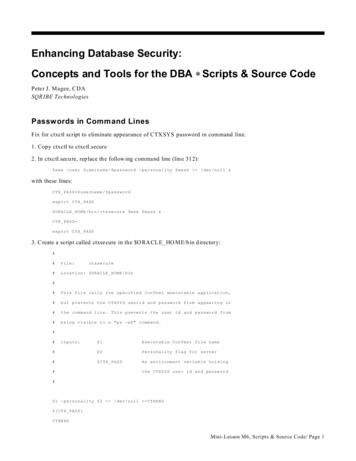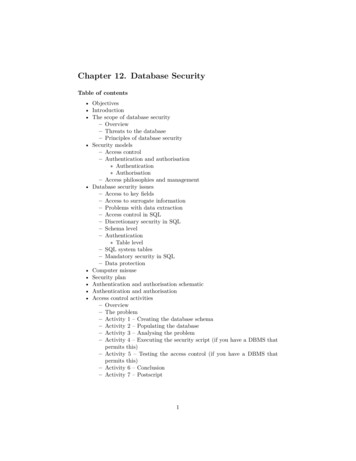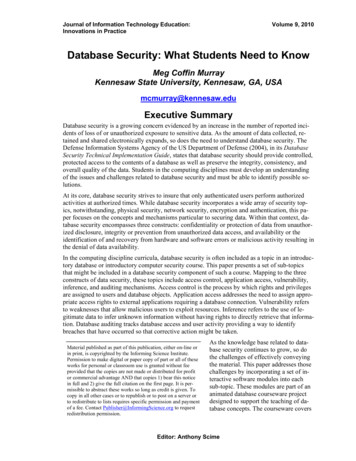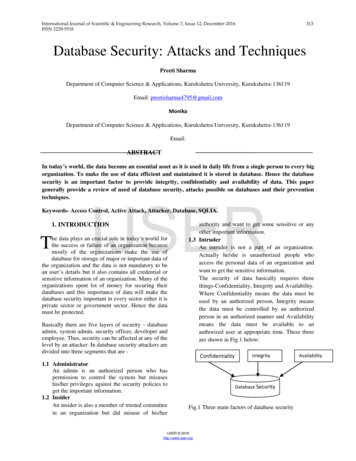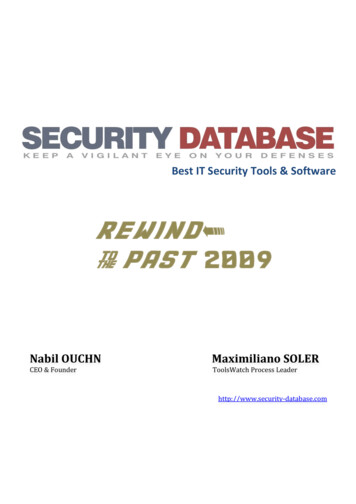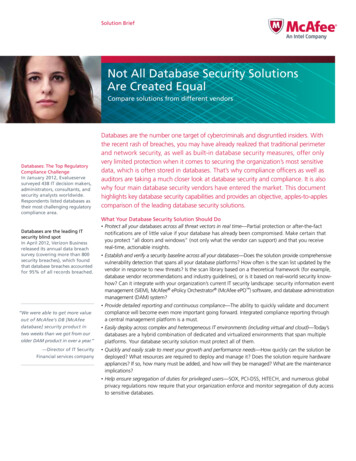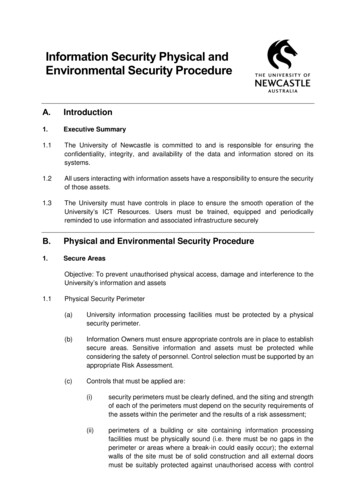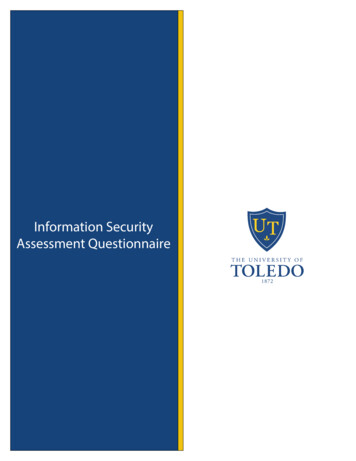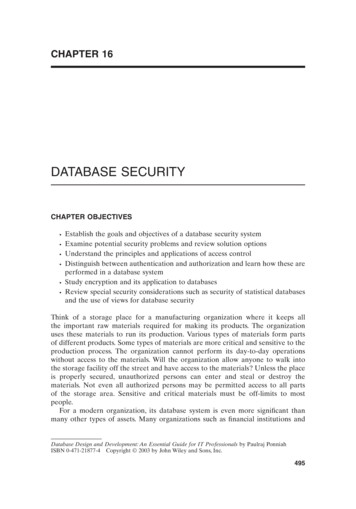
Transcription
CHAPTER 16DATABASE SECURITYCHAPTER OBJECTIVES Establish the goals and objectives of a database security systemExamine potential security problems and review solution optionsUnderstand the principles and applications of access controlDistinguish between authentication and authorization and learn how these areperformed in a database systemStudy encryption and its application to databasesReview special security considerations such as security of statistical databasesand the use of views for database securityThink of a storage place for a manufacturing organization where it keeps allthe important raw materials required for making its products. The organizationuses these materials to run its production. Various types of materials form partsof different products. Some types of materials are more critical and sensitive to theproduction process. The organization cannot perform its day-to-day operationswithout access to the materials. Will the organization allow anyone to walk intothe storage facility off the street and have access to the materials? Unless the placeis properly secured, unauthorized persons can enter and steal or destroy thematerials. Not even all authorized persons may be permitted access to all partsof the storage area. Sensitive and critical materials must be off-limits to mostpeople.For a modern organization, its database system is even more significant thanmany other types of assets. Many organizations such as financial institutions andDatabase Design and Development: An Essential Guide for IT Professionals by Paulraj PonniahISBN 0-471-21877-4 Copyright 2003 by John Wiley and Sons, Inc.495
496DATABASE SECURITYtravel companies cannot survive even a single day without their database systems.Any type of destruction of or unauthorized access to the database system has seriousimpact. Obviously, an organization must ensure that its database system is adequately guarded against accidental breaches of security or theft, misuse, and destruction through malicious intent.Every organization must protect its database system from intentional and unintentional threats. To do so, it must employ both computer-based and other types ofcontrols. The DBMS must include a proper security system to protect the databasefrom unauthorized access.SECURITY ISSUESWhat are we trying to protect by ensuring database security? What levels of information need to be safeguarded and how? What are the types of problems andthreats that deserve special attention? Can we distinguish between threats fromoutside and internal threats? Do these require different types of protection mechanisms? What are the solution options? How is protection of privacy related todatabase security?Let us address these broad questions before getting into specific access controltechniques. Many organizations are opening up their database systems for accessover the Internet. This openness results in great advantages but, at the same time,makes the database system vulnerable to threats from a much wider area. Websecurity demands special attention.Goals and ObjectivesSpecifically, what are we trying to protect? How are we planning to protect? Thesequestions form the basis for discussions on database security. Let us consider theprimary goals and objectives. Figure 16-1 provides an overview of the securitysystem for a database.Note the following three broad goals of database security highlighted in thefigure. Denial of access to the database by unauthorized usersGuarantee of access to all authorized usersProtection of privacy of dataIn a broad sense, you understand database security and what protection means.However, let us get into specific objectives. What are the particular objectivesto deal with individual types of threats? Here is a list of specific objectives of asecurity system:Shield from destruction. Shield the database from fire or any other such disaster.Safeguard from theft. Safeguard the database from malicious schemes of competitors or profiteers to steal the data content.
SECURITY ISSUES497DATABASEAuthorizedEnsuacce ress Protpriv ect Deacynacc yDBMessSUnauthorizedFigure 16-1 Database security system.Defense from vandalism. Defend the database from the attempts of ingenious,disgruntled professionals intending to tamper with and vandalize the database.Provide safety from fraud. Keep the database safe from persons with intentions tocommit fraud or to misuse its contents .Shelter of privacy. Shelter the privacy of individuals and institutions about whomdata reside in the database.Identification of users. Be able to positively identify authorized users.Authorization of users. Guarantee access to authorized users.Scope of authorization. Be able to authorize individual users for specific portionsof the database as needed.Levels of authorization. Provide individual users with particular authorizationlevels to read, update, add, or delete data.Monitoring of usage. Be able to monitor access by authorized users to keep audittrails for tracing actions.Security ProblemsMany aspects of security problems require attention in a database environment.Legal, social, and ethical aspects are involved. Does the person requesting for particular information have a legal right to that piece of information? Also, there are policyquestions about who decides on what types of access authorizations must be granted
498DATABASE SECURITYto whom and when. Operational and administrative aspects need to be considered.How do you allocate passwords, maintain them, and preserve confidentiality?What about physical controls to prevent problems? Should workstations andservers be guarded with physical lock-and-key schemes? Are hardware controlsavailable in your environment to be used for database security? Are there securityschemes in the operating system itself? Finally, what are the security provisionsin your DBMS, and to what extent can your environment take advantage of theseprovisions?To come up with solution options, first it will be worthwhile to classify the typesof security problems likely to be encountered. When you are able to classify thethreats, you will be able to find solutions to each type of problem. Broadly, we mayclassify the types of security exposure in a database environment as follows:Natural disasters. Fire, floods, and other such catastrophes.Human carelessness. Unintended damage caused by authorized users, especiallywhile running jobs in batch.Malicious damage. Sabotage, vandalism, actions of malicious programmers, technical support staff, and persons performing database administration functions.Crime. Theft, embezzlement, industrial espionage, and employees selling acompany’s secrets and data for mailing lists.Privacy invasion. Casual curiosity, data lookup by competitors, obtaining data forpolitical or legal reasons.Let us put together the components of the problems of database protection andsummarize the potential threats. Figure 16-2 presents a summary of threats to database security. Note each component showing the type of threat and its re 16-2 Threats to database security.
SECURITY ISSUES499Solution OptionsWe have looked at the types of potential threats to a database system. Various typesof sources pose different threats. How do you make provisions to protect your database system? When you consider each type of threat or problem, adopt a three-levelapproach to problem resolution: Minimize the probability of the problem happening. Establish enough protection rings to enclose the database system. Take all the necessary protectivemeasures and institute strong deterrents.Diminish the damage if it happens. If an intruder manages to penetrate theouter layer of protection, make it progressively difficult to cut through the innerlayers. Guard the most sensitive portions of the database with the moststringent security measures.Devise precise recovery schemes. If a vandal manages to destroy some partsof the database, have a tested method to recover from the damage. If a firedestroys your database, plan to be able to restore from a copy stored off-site.When you examine the types of threats, you will notice that most of therecovery solutions must be a combination of general control procedures andcomputer-based techniques. Let us explore the nature of these two types ofsolution methods.General Control Procedures These are matters of broad security policy andgeneral procedures. Although these procedures deal with the security of the database in a computer system, most of these do not involve the direct use of computers. Many of these relate to planning and policy-making. Some are physical controls,and a few others involve outside agencies. The following is a list of such securitymeasures.Physical controls. Include physical access to buildings, monitoring of visitors atentrances and exits, and guarding of workstations and servers.Human controls. Safeguard against threats from information system professionalsand specialists by proper security clearance to work on sensitive data.Control of equipment. Includes secure placement of equipment such as laptopsloaded with sensitive data and printers that are designated to print critical data.Security through outside agencies. Refers to third-party storage areas to keepbackup copies of database and outside installations that can be used for disasterrecovery.Contingency Plans. Intended to be adopted in case of fire or bomb alerts. Plansmust include designation of responsibilities and procedures for recovery.Security Policy. An essential element of the security system to address the scopeof the security schemes, the duties and responsibilities of employees, the procedures
500DATABASE SECURITYto be followed, and disciplinary action in the event of noncompliance with policyand procedures.Computer-Based Techniques Now let us turn our attention to the types ofcountermeasures that are executed through the use of the computer system including the DBMS. Here is a list of the major techniques:Authorization of users. Includes authentication of authorized users and granting ofaccess privileges to them.Tailoring authorization through views. Defining user views to have the ability toauthorize users for specific portions of the database.Backup and recovery. Creation of backup copies of the database at regularintervals and also testing and implementing recovery procedures.Protection of sensitive data. Use of encryption technology to protect sensitive data.All DBMSs have security systems to guarantee database access to authorizedusers. Commonly, these security mechanisms are referred to as discretionary andmandatory security mechanisms. Let us define the scope of this division:Discretionary security mechanisms. Used for granting and revoking data accessprivileges to users for accessing specific parts of a database in any of the accessmodes of read, update, add, and delete.Mandatory security mechanisms. Used for establishing security at multiple levelsby classifying users into distinct groups and grouping data into distinct segmentsand, thereafter, assigning access privileges for particular user groups to datasegments.From our discussions so far, you must have concluded that database security iscritical but also difficult. You must look toward enforcing database security at different levels. Security mechanisms must exist at several layers such as within thedatabase system itself, at the level of the operating system, the network, the application, the hardware, and so on. Figure 16-3 clearly illustrates the layers of controlfor database security.Privacy IssuesBusinesses and government agencies collect and store large volumes of informationabout customers, suppliers, distributors, and employees. Data privacy concerns thosekinds of information that relate to individuals and external organizations that arepart of the company’s database. Who owns this information—the company that hasthe database or the individuals and organizations to whom the information relates?Who can access this information? Can this information be sold to others? What arethe regulations?Data privacy fits into data security in an unorthodox manner. Data security isgenerally thought of as the protection of a company’s data from unauthorizedaccess. Who authorizes access, and who decides on how and to whom access must
ACCESS ministrativeLegal/societalFigure 16-3 Database security: layers of control.be granted? Of course, the company does this because it is deemed that the companyowns the data in the database. In the same way, data privacy may be thought of asprotecting information about employees, customers, suppliers, and distributors fromunauthorized access. Who decides on this authorization? Naturally, the owners mustmake the decision. Who are the owners—the company or those about whom information is collected and stored?Privacy issues are becoming more and more sensitive in North America, as theyhave been in Europe for some time. Legislation about privacy and confidentialityof information varies from region to region. Some basic rights are available to thoseabout whom data is retained in corporate databases. Individuals and institutionsmay inquire about what information about them is stored and may demand tocorrect any information about them. Privacy concerns escalate with the widespreaduse of the Internet. Although formal regulations may not be adequate, organizations are ethically obliged to prevent misuse of the information they collect aboutindividuals and third-party institutions.Web SecurityWhile discussing database security, it is important to mention security mechanismsas they relate to the DBMS and the Web. We will discuss these security options inChapter 19, which is dedicated to the topic of the database and the Web. Securityoptions
DATABASE SECURITY CHAPTER OBJECTIVES Establish the goals and objectives of a database security system Examine potential security problems and review solution options Understand the principles and applications of access control Distinguish between authentication and authorization and learn how these are performed in a database system


